MN502 - Lightweight Cryptography: Security Threats and Solutions
VerifiedAdded on 2023/04/20
|8
|2332
|431
Report
AI Summary
This report provides an overview of lightweight cryptography, a technology aimed at improving the performance and security of computer devices and networks, especially those with low computing power. It discusses security threats associated with low-power devices, including confidentiality breaches, authentication issues, denial-of-service attacks, and malware. The report details the working mechanism of lightweight cryptography, covering lightweight block ciphers, hash functions, stream ciphers, and one-pass authenticated ciphers. Performance metrics, including both hardware-specific (encryption time, throughput, CPU usage) and software-specific metrics (planning, control, organization), are examined. Various algorithms like block ciphers and stream ciphers are also discussed, along with current and future challenges such as security vulnerabilities, authentication problems, data breaches and cryptographic algorithm limitations. The report concludes by emphasizing the importance of encryption and decryption techniques in managing security threats and enhancing system performance.

Overview of network security
Paraphrase This Document
Need a fresh take? Get an instant paraphrase of this document with our AI Paraphraser
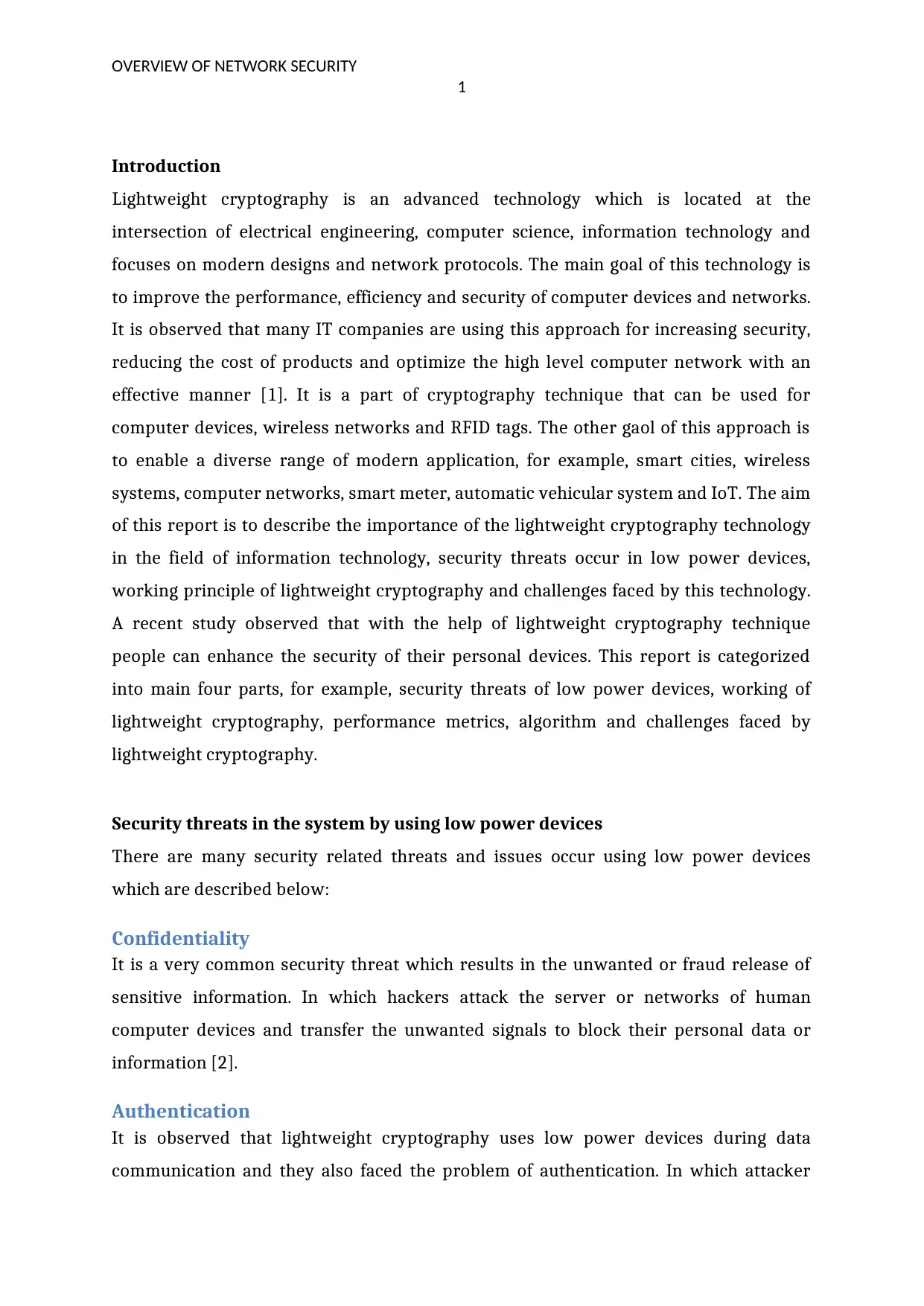
OVERVIEW OF NETWORK SECURITY
1
Introduction
Lightweight cryptography is an advanced technology which is located at the
intersection of electrical engineering, computer science, information technology and
focuses on modern designs and network protocols. The main goal of this technology is
to improve the performance, efficiency and security of computer devices and networks.
It is observed that many IT companies are using this approach for increasing security,
reducing the cost of products and optimize the high level computer network with an
effective manner [1]. It is a part of cryptography technique that can be used for
computer devices, wireless networks and RFID tags. The other gaol of this approach is
to enable a diverse range of modern application, for example, smart cities, wireless
systems, computer networks, smart meter, automatic vehicular system and IoT. The aim
of this report is to describe the importance of the lightweight cryptography technology
in the field of information technology, security threats occur in low power devices,
working principle of lightweight cryptography and challenges faced by this technology.
A recent study observed that with the help of lightweight cryptography technique
people can enhance the security of their personal devices. This report is categorized
into main four parts, for example, security threats of low power devices, working of
lightweight cryptography, performance metrics, algorithm and challenges faced by
lightweight cryptography.
Security threats in the system by using low power devices
There are many security related threats and issues occur using low power devices
which are described below:
Confidentiality
It is a very common security threat which results in the unwanted or fraud release of
sensitive information. In which hackers attack the server or networks of human
computer devices and transfer the unwanted signals to block their personal data or
information [2].
Authentication
It is observed that lightweight cryptography uses low power devices during data
communication and they also faced the problem of authentication. In which attacker
1
Introduction
Lightweight cryptography is an advanced technology which is located at the
intersection of electrical engineering, computer science, information technology and
focuses on modern designs and network protocols. The main goal of this technology is
to improve the performance, efficiency and security of computer devices and networks.
It is observed that many IT companies are using this approach for increasing security,
reducing the cost of products and optimize the high level computer network with an
effective manner [1]. It is a part of cryptography technique that can be used for
computer devices, wireless networks and RFID tags. The other gaol of this approach is
to enable a diverse range of modern application, for example, smart cities, wireless
systems, computer networks, smart meter, automatic vehicular system and IoT. The aim
of this report is to describe the importance of the lightweight cryptography technology
in the field of information technology, security threats occur in low power devices,
working principle of lightweight cryptography and challenges faced by this technology.
A recent study observed that with the help of lightweight cryptography technique
people can enhance the security of their personal devices. This report is categorized
into main four parts, for example, security threats of low power devices, working of
lightweight cryptography, performance metrics, algorithm and challenges faced by
lightweight cryptography.
Security threats in the system by using low power devices
There are many security related threats and issues occur using low power devices
which are described below:
Confidentiality
It is a very common security threat which results in the unwanted or fraud release of
sensitive information. In which hackers attack the server or networks of human
computer devices and transfer the unwanted signals to block their personal data or
information [2].
Authentication
It is observed that lightweight cryptography uses low power devices during data
communication and they also faced the problem of authentication. In which attacker
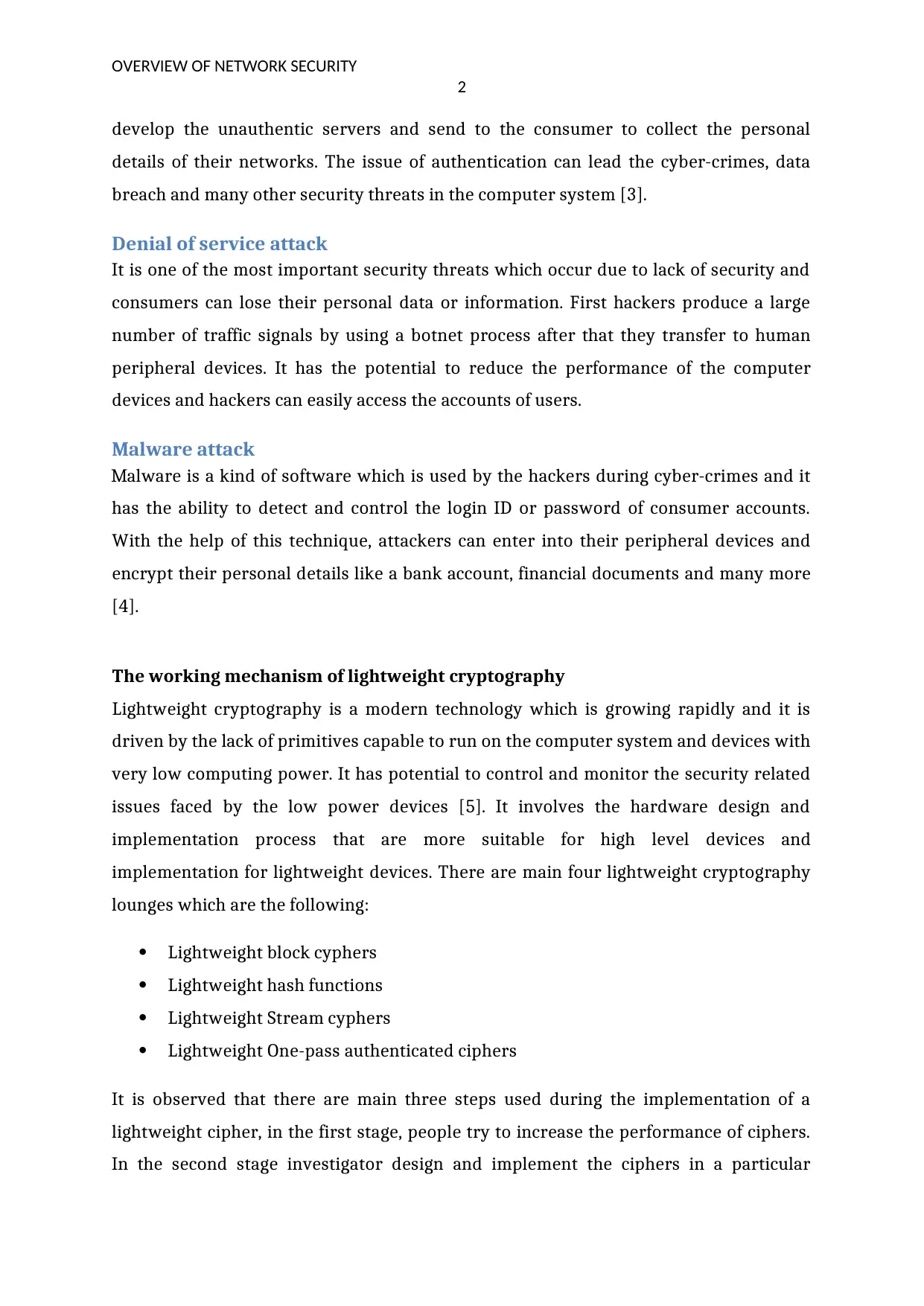
OVERVIEW OF NETWORK SECURITY
2
develop the unauthentic servers and send to the consumer to collect the personal
details of their networks. The issue of authentication can lead the cyber-crimes, data
breach and many other security threats in the computer system [3].
Denial of service attack
It is one of the most important security threats which occur due to lack of security and
consumers can lose their personal data or information. First hackers produce a large
number of traffic signals by using a botnet process after that they transfer to human
peripheral devices. It has the potential to reduce the performance of the computer
devices and hackers can easily access the accounts of users.
Malware attack
Malware is a kind of software which is used by the hackers during cyber-crimes and it
has the ability to detect and control the login ID or password of consumer accounts.
With the help of this technique, attackers can enter into their peripheral devices and
encrypt their personal details like a bank account, financial documents and many more
[4].
The working mechanism of lightweight cryptography
Lightweight cryptography is a modern technology which is growing rapidly and it is
driven by the lack of primitives capable to run on the computer system and devices with
very low computing power. It has potential to control and monitor the security related
issues faced by the low power devices [5]. It involves the hardware design and
implementation process that are more suitable for high level devices and
implementation for lightweight devices. There are main four lightweight cryptography
lounges which are the following:
Lightweight block cyphers
Lightweight hash functions
Lightweight Stream cyphers
Lightweight One-pass authenticated ciphers
It is observed that there are main three steps used during the implementation of a
lightweight cipher, in the first stage, people try to increase the performance of ciphers.
In the second stage investigator design and implement the ciphers in a particular
2
develop the unauthentic servers and send to the consumer to collect the personal
details of their networks. The issue of authentication can lead the cyber-crimes, data
breach and many other security threats in the computer system [3].
Denial of service attack
It is one of the most important security threats which occur due to lack of security and
consumers can lose their personal data or information. First hackers produce a large
number of traffic signals by using a botnet process after that they transfer to human
peripheral devices. It has the potential to reduce the performance of the computer
devices and hackers can easily access the accounts of users.
Malware attack
Malware is a kind of software which is used by the hackers during cyber-crimes and it
has the ability to detect and control the login ID or password of consumer accounts.
With the help of this technique, attackers can enter into their peripheral devices and
encrypt their personal details like a bank account, financial documents and many more
[4].
The working mechanism of lightweight cryptography
Lightweight cryptography is a modern technology which is growing rapidly and it is
driven by the lack of primitives capable to run on the computer system and devices with
very low computing power. It has potential to control and monitor the security related
issues faced by the low power devices [5]. It involves the hardware design and
implementation process that are more suitable for high level devices and
implementation for lightweight devices. There are main four lightweight cryptography
lounges which are the following:
Lightweight block cyphers
Lightweight hash functions
Lightweight Stream cyphers
Lightweight One-pass authenticated ciphers
It is observed that there are main three steps used during the implementation of a
lightweight cipher, in the first stage, people try to increase the performance of ciphers.
In the second stage investigator design and implement the ciphers in a particular
⊘ This is a preview!⊘
Do you want full access?
Subscribe today to unlock all pages.

Trusted by 1+ million students worldwide
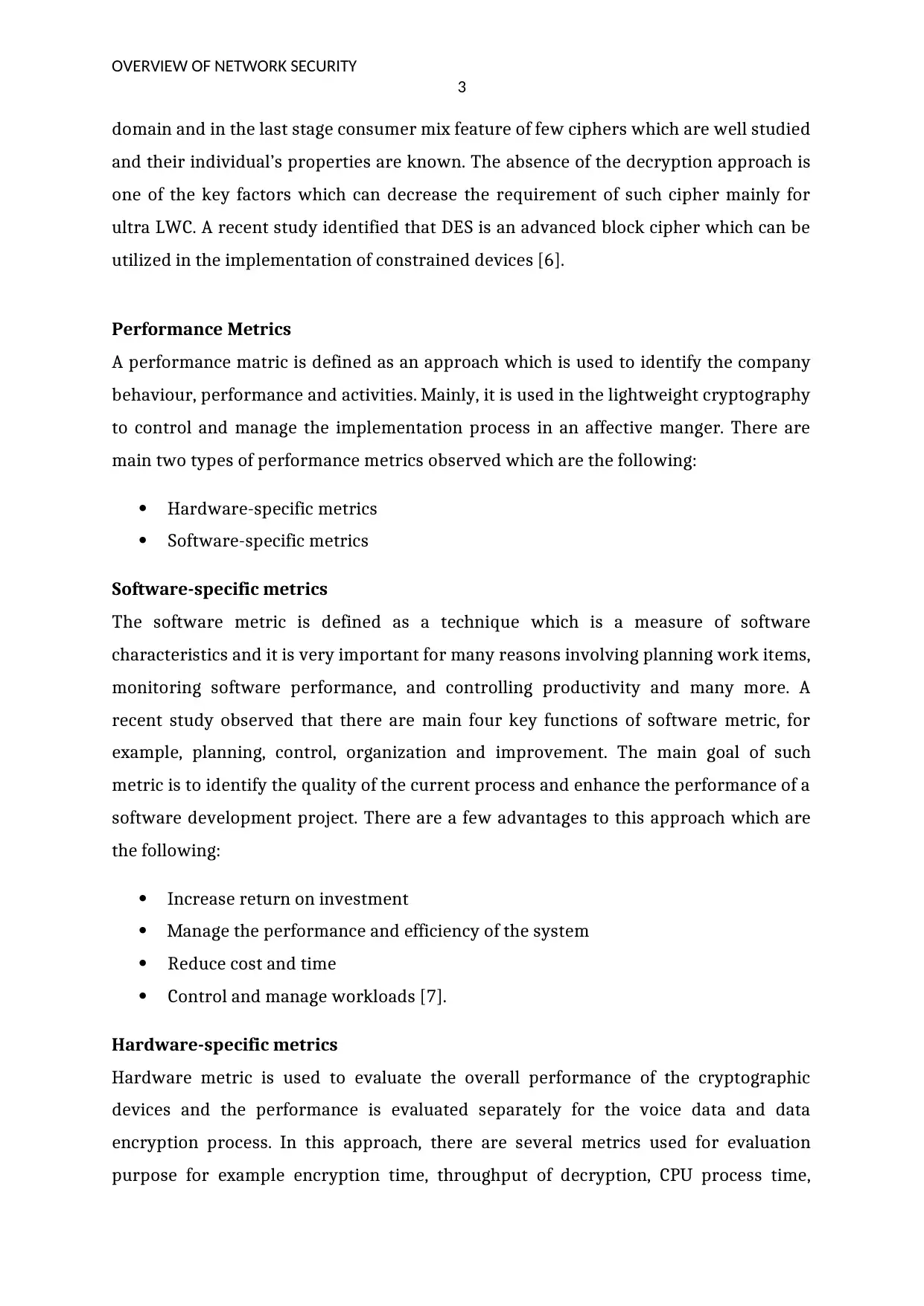
OVERVIEW OF NETWORK SECURITY
3
domain and in the last stage consumer mix feature of few ciphers which are well studied
and their individual’s properties are known. The absence of the decryption approach is
one of the key factors which can decrease the requirement of such cipher mainly for
ultra LWC. A recent study identified that DES is an advanced block cipher which can be
utilized in the implementation of constrained devices [6].
Performance Metrics
A performance matric is defined as an approach which is used to identify the company
behaviour, performance and activities. Mainly, it is used in the lightweight cryptography
to control and manage the implementation process in an affective manger. There are
main two types of performance metrics observed which are the following:
Hardware-specific metrics
Software-specific metrics
Software-specific metrics
The software metric is defined as a technique which is a measure of software
characteristics and it is very important for many reasons involving planning work items,
monitoring software performance, and controlling productivity and many more. A
recent study observed that there are main four key functions of software metric, for
example, planning, control, organization and improvement. The main goal of such
metric is to identify the quality of the current process and enhance the performance of a
software development project. There are a few advantages to this approach which are
the following:
Increase return on investment
Manage the performance and efficiency of the system
Reduce cost and time
Control and manage workloads [7].
Hardware-specific metrics
Hardware metric is used to evaluate the overall performance of the cryptographic
devices and the performance is evaluated separately for the voice data and data
encryption process. In this approach, there are several metrics used for evaluation
purpose for example encryption time, throughput of decryption, CPU process time,
3
domain and in the last stage consumer mix feature of few ciphers which are well studied
and their individual’s properties are known. The absence of the decryption approach is
one of the key factors which can decrease the requirement of such cipher mainly for
ultra LWC. A recent study identified that DES is an advanced block cipher which can be
utilized in the implementation of constrained devices [6].
Performance Metrics
A performance matric is defined as an approach which is used to identify the company
behaviour, performance and activities. Mainly, it is used in the lightweight cryptography
to control and manage the implementation process in an affective manger. There are
main two types of performance metrics observed which are the following:
Hardware-specific metrics
Software-specific metrics
Software-specific metrics
The software metric is defined as a technique which is a measure of software
characteristics and it is very important for many reasons involving planning work items,
monitoring software performance, and controlling productivity and many more. A
recent study observed that there are main four key functions of software metric, for
example, planning, control, organization and improvement. The main goal of such
metric is to identify the quality of the current process and enhance the performance of a
software development project. There are a few advantages to this approach which are
the following:
Increase return on investment
Manage the performance and efficiency of the system
Reduce cost and time
Control and manage workloads [7].
Hardware-specific metrics
Hardware metric is used to evaluate the overall performance of the cryptographic
devices and the performance is evaluated separately for the voice data and data
encryption process. In this approach, there are several metrics used for evaluation
purpose for example encryption time, throughput of decryption, CPU process time,
Paraphrase This Document
Need a fresh take? Get an instant paraphrase of this document with our AI Paraphraser
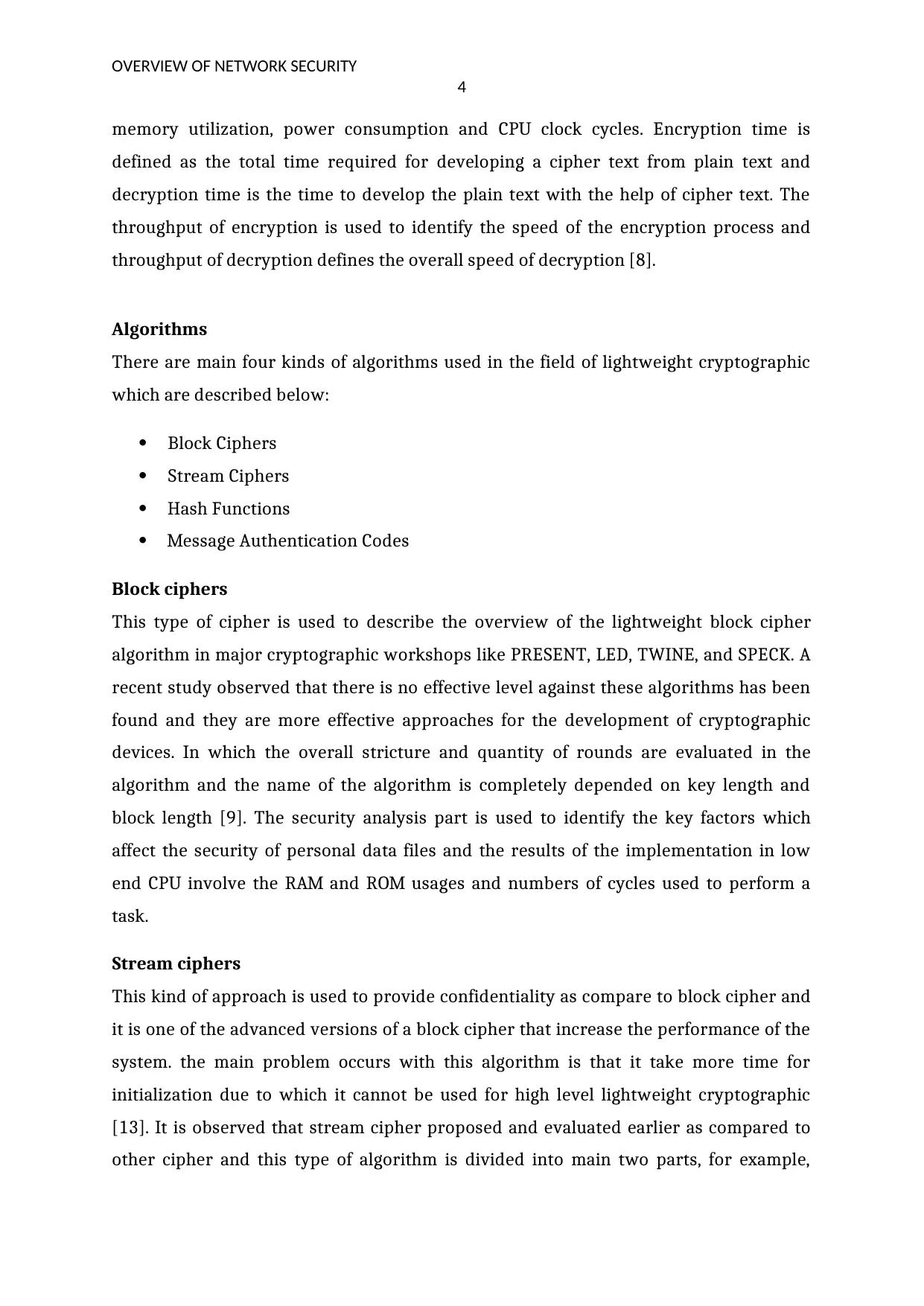
OVERVIEW OF NETWORK SECURITY
4
memory utilization, power consumption and CPU clock cycles. Encryption time is
defined as the total time required for developing a cipher text from plain text and
decryption time is the time to develop the plain text with the help of cipher text. The
throughput of encryption is used to identify the speed of the encryption process and
throughput of decryption defines the overall speed of decryption [8].
Algorithms
There are main four kinds of algorithms used in the field of lightweight cryptographic
which are described below:
Block Ciphers
Stream Ciphers
Hash Functions
Message Authentication Codes
Block ciphers
This type of cipher is used to describe the overview of the lightweight block cipher
algorithm in major cryptographic workshops like PRESENT, LED, TWINE, and SPECK. A
recent study observed that there is no effective level against these algorithms has been
found and they are more effective approaches for the development of cryptographic
devices. In which the overall stricture and quantity of rounds are evaluated in the
algorithm and the name of the algorithm is completely depended on key length and
block length [9]. The security analysis part is used to identify the key factors which
affect the security of personal data files and the results of the implementation in low
end CPU involve the RAM and ROM usages and numbers of cycles used to perform a
task.
Stream ciphers
This kind of approach is used to provide confidentiality as compare to block cipher and
it is one of the advanced versions of a block cipher that increase the performance of the
system. the main problem occurs with this algorithm is that it take more time for
initialization due to which it cannot be used for high level lightweight cryptographic
[13]. It is observed that stream cipher proposed and evaluated earlier as compared to
other cipher and this type of algorithm is divided into main two parts, for example,
4
memory utilization, power consumption and CPU clock cycles. Encryption time is
defined as the total time required for developing a cipher text from plain text and
decryption time is the time to develop the plain text with the help of cipher text. The
throughput of encryption is used to identify the speed of the encryption process and
throughput of decryption defines the overall speed of decryption [8].
Algorithms
There are main four kinds of algorithms used in the field of lightweight cryptographic
which are described below:
Block Ciphers
Stream Ciphers
Hash Functions
Message Authentication Codes
Block ciphers
This type of cipher is used to describe the overview of the lightweight block cipher
algorithm in major cryptographic workshops like PRESENT, LED, TWINE, and SPECK. A
recent study observed that there is no effective level against these algorithms has been
found and they are more effective approaches for the development of cryptographic
devices. In which the overall stricture and quantity of rounds are evaluated in the
algorithm and the name of the algorithm is completely depended on key length and
block length [9]. The security analysis part is used to identify the key factors which
affect the security of personal data files and the results of the implementation in low
end CPU involve the RAM and ROM usages and numbers of cycles used to perform a
task.
Stream ciphers
This kind of approach is used to provide confidentiality as compare to block cipher and
it is one of the advanced versions of a block cipher that increase the performance of the
system. the main problem occurs with this algorithm is that it take more time for
initialization due to which it cannot be used for high level lightweight cryptographic
[13]. It is observed that stream cipher proposed and evaluated earlier as compared to
other cipher and this type of algorithm is divided into main two parts, for example,
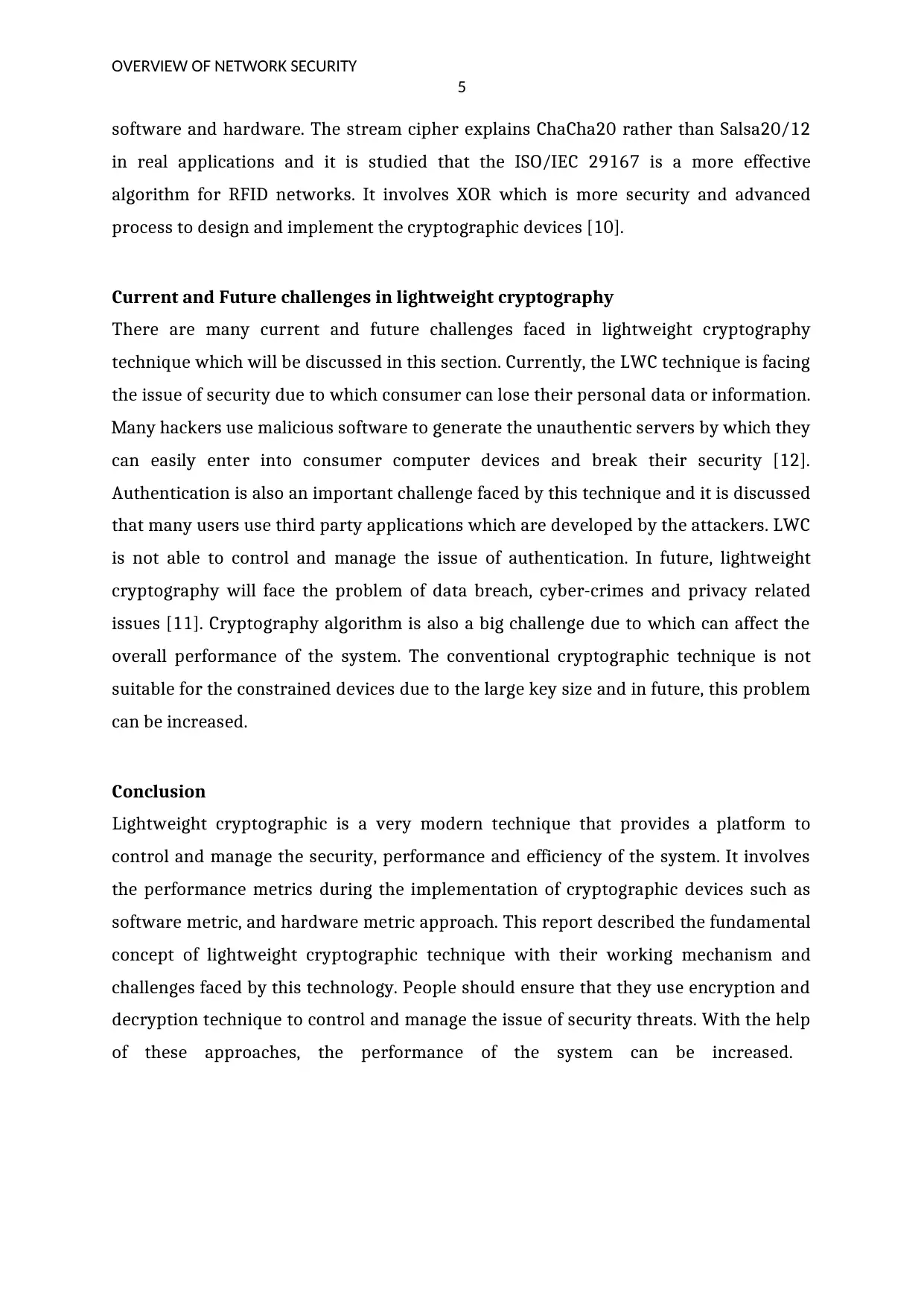
OVERVIEW OF NETWORK SECURITY
5
software and hardware. The stream cipher explains ChaCha20 rather than Salsa20/12
in real applications and it is studied that the ISO/IEC 29167 is a more effective
algorithm for RFID networks. It involves XOR which is more security and advanced
process to design and implement the cryptographic devices [10].
Current and Future challenges in lightweight cryptography
There are many current and future challenges faced in lightweight cryptography
technique which will be discussed in this section. Currently, the LWC technique is facing
the issue of security due to which consumer can lose their personal data or information.
Many hackers use malicious software to generate the unauthentic servers by which they
can easily enter into consumer computer devices and break their security [12].
Authentication is also an important challenge faced by this technique and it is discussed
that many users use third party applications which are developed by the attackers. LWC
is not able to control and manage the issue of authentication. In future, lightweight
cryptography will face the problem of data breach, cyber-crimes and privacy related
issues [11]. Cryptography algorithm is also a big challenge due to which can affect the
overall performance of the system. The conventional cryptographic technique is not
suitable for the constrained devices due to the large key size and in future, this problem
can be increased.
Conclusion
Lightweight cryptographic is a very modern technique that provides a platform to
control and manage the security, performance and efficiency of the system. It involves
the performance metrics during the implementation of cryptographic devices such as
software metric, and hardware metric approach. This report described the fundamental
concept of lightweight cryptographic technique with their working mechanism and
challenges faced by this technology. People should ensure that they use encryption and
decryption technique to control and manage the issue of security threats. With the help
of these approaches, the performance of the system can be increased.
5
software and hardware. The stream cipher explains ChaCha20 rather than Salsa20/12
in real applications and it is studied that the ISO/IEC 29167 is a more effective
algorithm for RFID networks. It involves XOR which is more security and advanced
process to design and implement the cryptographic devices [10].
Current and Future challenges in lightweight cryptography
There are many current and future challenges faced in lightweight cryptography
technique which will be discussed in this section. Currently, the LWC technique is facing
the issue of security due to which consumer can lose their personal data or information.
Many hackers use malicious software to generate the unauthentic servers by which they
can easily enter into consumer computer devices and break their security [12].
Authentication is also an important challenge faced by this technique and it is discussed
that many users use third party applications which are developed by the attackers. LWC
is not able to control and manage the issue of authentication. In future, lightweight
cryptography will face the problem of data breach, cyber-crimes and privacy related
issues [11]. Cryptography algorithm is also a big challenge due to which can affect the
overall performance of the system. The conventional cryptographic technique is not
suitable for the constrained devices due to the large key size and in future, this problem
can be increased.
Conclusion
Lightweight cryptographic is a very modern technique that provides a platform to
control and manage the security, performance and efficiency of the system. It involves
the performance metrics during the implementation of cryptographic devices such as
software metric, and hardware metric approach. This report described the fundamental
concept of lightweight cryptographic technique with their working mechanism and
challenges faced by this technology. People should ensure that they use encryption and
decryption technique to control and manage the issue of security threats. With the help
of these approaches, the performance of the system can be increased.
⊘ This is a preview!⊘
Do you want full access?
Subscribe today to unlock all pages.

Trusted by 1+ million students worldwide
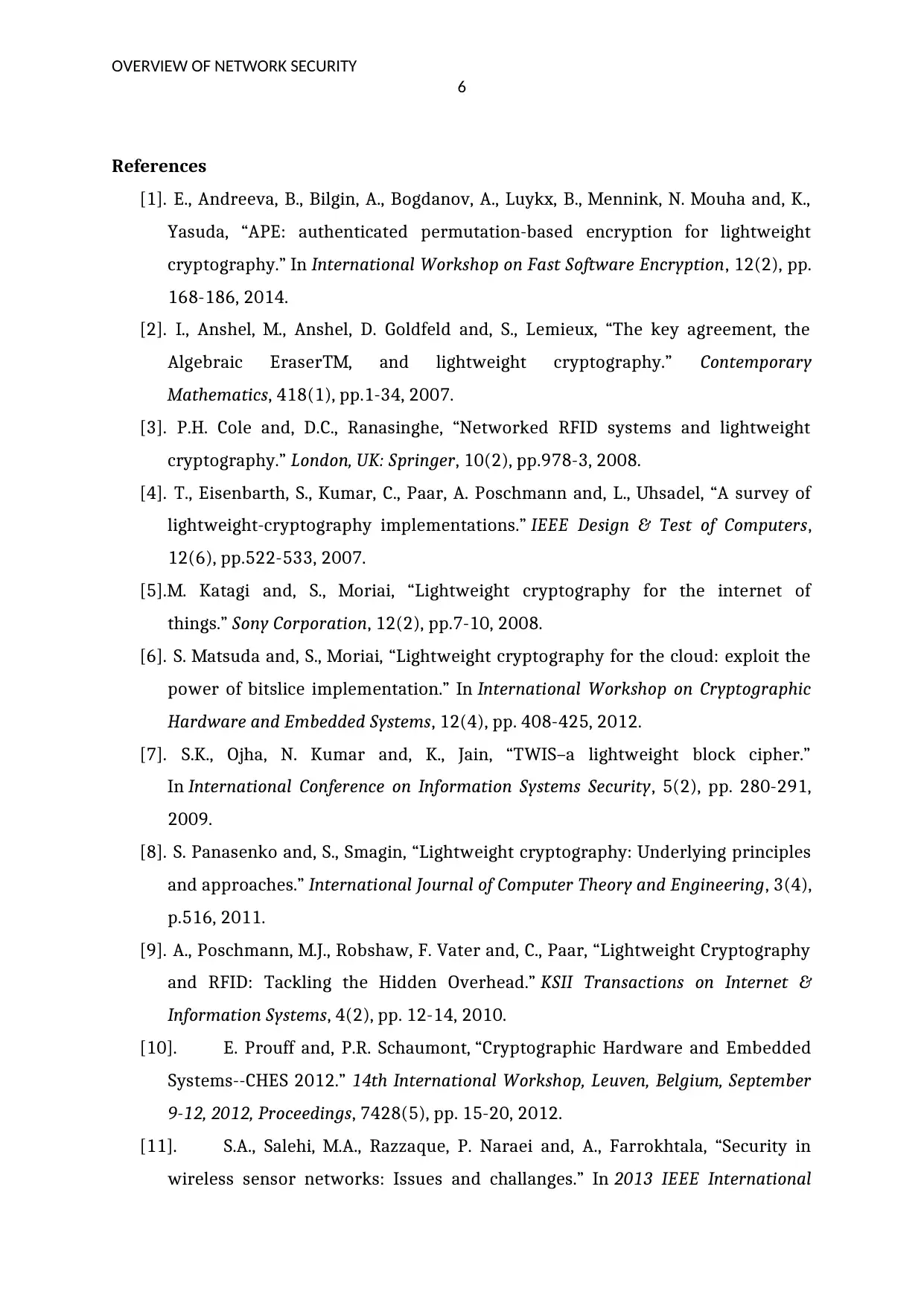
OVERVIEW OF NETWORK SECURITY
6
References
[1]. E., Andreeva, B., Bilgin, A., Bogdanov, A., Luykx, B., Mennink, N. Mouha and, K.,
Yasuda, “APE: authenticated permutation-based encryption for lightweight
cryptography.” In International Workshop on Fast Software Encryption, 12(2), pp.
168-186, 2014.
[2]. I., Anshel, M., Anshel, D. Goldfeld and, S., Lemieux, “The key agreement, the
Algebraic EraserTM, and lightweight cryptography.” Contemporary
Mathematics, 418(1), pp.1-34, 2007.
[3]. P.H. Cole and, D.C., Ranasinghe, “Networked RFID systems and lightweight
cryptography.” London, UK: Springer, 10(2), pp.978-3, 2008.
[4]. T., Eisenbarth, S., Kumar, C., Paar, A. Poschmann and, L., Uhsadel, “A survey of
lightweight-cryptography implementations.” IEEE Design & Test of Computers,
12(6), pp.522-533, 2007.
[5].M. Katagi and, S., Moriai, “Lightweight cryptography for the internet of
things.” Sony Corporation, 12(2), pp.7-10, 2008.
[6]. S. Matsuda and, S., Moriai, “Lightweight cryptography for the cloud: exploit the
power of bitslice implementation.” In International Workshop on Cryptographic
Hardware and Embedded Systems, 12(4), pp. 408-425, 2012.
[7]. S.K., Ojha, N. Kumar and, K., Jain, “TWIS–a lightweight block cipher.”
In International Conference on Information Systems Security, 5(2), pp. 280-291,
2009.
[8]. S. Panasenko and, S., Smagin, “Lightweight cryptography: Underlying principles
and approaches.” International Journal of Computer Theory and Engineering, 3(4),
p.516, 2011.
[9]. A., Poschmann, M.J., Robshaw, F. Vater and, C., Paar, “Lightweight Cryptography
and RFID: Tackling the Hidden Overhead.” KSII Transactions on Internet &
Information Systems, 4(2), pp. 12-14, 2010.
[10]. E. Prouff and, P.R. Schaumont, “Cryptographic Hardware and Embedded
Systems--CHES 2012.” 14th International Workshop, Leuven, Belgium, September
9-12, 2012, Proceedings, 7428(5), pp. 15-20, 2012.
[11]. S.A., Salehi, M.A., Razzaque, P. Naraei and, A., Farrokhtala, “Security in
wireless sensor networks: Issues and challanges.” In 2013 IEEE International
6
References
[1]. E., Andreeva, B., Bilgin, A., Bogdanov, A., Luykx, B., Mennink, N. Mouha and, K.,
Yasuda, “APE: authenticated permutation-based encryption for lightweight
cryptography.” In International Workshop on Fast Software Encryption, 12(2), pp.
168-186, 2014.
[2]. I., Anshel, M., Anshel, D. Goldfeld and, S., Lemieux, “The key agreement, the
Algebraic EraserTM, and lightweight cryptography.” Contemporary
Mathematics, 418(1), pp.1-34, 2007.
[3]. P.H. Cole and, D.C., Ranasinghe, “Networked RFID systems and lightweight
cryptography.” London, UK: Springer, 10(2), pp.978-3, 2008.
[4]. T., Eisenbarth, S., Kumar, C., Paar, A. Poschmann and, L., Uhsadel, “A survey of
lightweight-cryptography implementations.” IEEE Design & Test of Computers,
12(6), pp.522-533, 2007.
[5].M. Katagi and, S., Moriai, “Lightweight cryptography for the internet of
things.” Sony Corporation, 12(2), pp.7-10, 2008.
[6]. S. Matsuda and, S., Moriai, “Lightweight cryptography for the cloud: exploit the
power of bitslice implementation.” In International Workshop on Cryptographic
Hardware and Embedded Systems, 12(4), pp. 408-425, 2012.
[7]. S.K., Ojha, N. Kumar and, K., Jain, “TWIS–a lightweight block cipher.”
In International Conference on Information Systems Security, 5(2), pp. 280-291,
2009.
[8]. S. Panasenko and, S., Smagin, “Lightweight cryptography: Underlying principles
and approaches.” International Journal of Computer Theory and Engineering, 3(4),
p.516, 2011.
[9]. A., Poschmann, M.J., Robshaw, F. Vater and, C., Paar, “Lightweight Cryptography
and RFID: Tackling the Hidden Overhead.” KSII Transactions on Internet &
Information Systems, 4(2), pp. 12-14, 2010.
[10]. E. Prouff and, P.R. Schaumont, “Cryptographic Hardware and Embedded
Systems--CHES 2012.” 14th International Workshop, Leuven, Belgium, September
9-12, 2012, Proceedings, 7428(5), pp. 15-20, 2012.
[11]. S.A., Salehi, M.A., Razzaque, P. Naraei and, A., Farrokhtala, “Security in
wireless sensor networks: Issues and challanges.” In 2013 IEEE International
Paraphrase This Document
Need a fresh take? Get an instant paraphrase of this document with our AI Paraphraser

OVERVIEW OF NETWORK SECURITY
7
Conference on Space Science and Communication (IconSpace), 8(2), pp. 356-360,
2013.
[12]. S. Sarkar and S.M., Sim, “A deeper understanding of the XOR count
distribution in the context of lightweight cryptography.” In International
Conference on Cryptology in Africa, 14(5), pp. 167-182, 2016.
[13]. P. Yalla and, J.P., Kaps, “Lightweight cryptography for FPGAs.”
In Reconfigurable Computing and FPGAs, 2009. ReConFig'09. International
Conference on, 6(2), pp. 225-230, 2009.
7
Conference on Space Science and Communication (IconSpace), 8(2), pp. 356-360,
2013.
[12]. S. Sarkar and S.M., Sim, “A deeper understanding of the XOR count
distribution in the context of lightweight cryptography.” In International
Conference on Cryptology in Africa, 14(5), pp. 167-182, 2016.
[13]. P. Yalla and, J.P., Kaps, “Lightweight cryptography for FPGAs.”
In Reconfigurable Computing and FPGAs, 2009. ReConFig'09. International
Conference on, 6(2), pp. 225-230, 2009.
1 out of 8
Related Documents
Your All-in-One AI-Powered Toolkit for Academic Success.
+13062052269
info@desklib.com
Available 24*7 on WhatsApp / Email
![[object Object]](/_next/static/media/star-bottom.7253800d.svg)
Unlock your academic potential
Copyright © 2020–2025 A2Z Services. All Rights Reserved. Developed and managed by ZUCOL.




